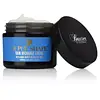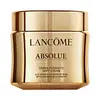What's inside
What's inside
 Key Ingredients
Key Ingredients

 Benefits
Benefits

 Concerns
Concerns

 Ingredients Side-by-side
Ingredients Side-by-side

Water
Skin ConditioningGlycerin
HumectantDimethicone
EmollientIsononyl Isononanoate
EmollientAlcohol Denat.
AntimicrobialPrunus Armeniaca Kernel Oil
MaskingPolysorbate 20
EmulsifyingPropanediol
SolventPEG-20 Methyl Glucose Sesquistearate
EmulsifyingAmmonium Polyacryloyldimethyl Taurate
Emulsion StabilisingPolyacrylamide
Phenoxyethanol
PreservativeCaprylyl Glycol
EmollientHydroxypropyl Tetrahydropyrantriol
Skin ConditioningC13-14 Isoparaffin
EmollientPropylene Glycol
HumectantCaffeine
Skin ConditioningVigna Aconitifolia Seed Extract
Skin ConditioningDisodium EDTA
Laureth-7
EmulsifyingBHT
AntioxidantMagnesium Gluconate
Skin ConditioningXanthan Gum
EmulsifyingSodium Cocoyl Glutamate
CleansingPentylene Glycol
Skin ConditioningHydrolyzed Soy Protein
HumectantT-Butyl Alcohol
PerfumingTocopherol
AntioxidantWater, Glycerin, Dimethicone, Isononyl Isononanoate, Alcohol Denat., Prunus Armeniaca Kernel Oil, Polysorbate 20, Propanediol, PEG-20 Methyl Glucose Sesquistearate, Ammonium Polyacryloyldimethyl Taurate, Polyacrylamide, Phenoxyethanol, Caprylyl Glycol, Hydroxypropyl Tetrahydropyrantriol, C13-14 Isoparaffin, Propylene Glycol, Caffeine, Vigna Aconitifolia Seed Extract, Disodium EDTA, Laureth-7, BHT, Magnesium Gluconate, Xanthan Gum, Sodium Cocoyl Glutamate, Pentylene Glycol, Hydrolyzed Soy Protein, T-Butyl Alcohol, Tocopherol
Water
Skin ConditioningOctocrylene
UV AbsorberHydrogenated Polyisobutene
EmollientEthylhexyl Salicylate
UV AbsorberAlcohol Denat.
AntimicrobialDimethicone
EmollientGlycerin
HumectantButyl Methoxydibenzoylmethane
UV AbsorberBis-PEG-18 Methyl Ether Dimethyl Silane
EmollientOctyldodecanol
EmollientCetearyl Alcohol
EmollientPEG-20
HumectantPetrolatum
EmollientButyrospermum Parkii Butter
Skin ConditioningCetyl Alcohol
EmollientHydroxypropyl Tetrahydropyrantriol
Skin ConditioningPhenoxyethanol
PreservativePropylene Glycol
HumectantButylene Glycol
HumectantZea Mays Oil
EmulsifyingPrunus Armeniaca Kernel Oil
MaskingTocopheryl Acetate
AntioxidantPassiflora Edulis Seed Oil
EmollientOryza Sativa Bran Oil
EmollientCetearyl Glucoside
EmulsifyingCaprylyl Glycol
EmollientPolyacrylamide
PEG-100 Stearate
Glyceryl Stearate
EmollientXanthan Gum
EmulsifyingCapryloyl Salicylic Acid
ExfoliatingAcrylates/C10-30 Alkyl Acrylate Crosspolymer
Emulsion StabilisingC13-14 Isoparaffin
EmollientDisodium EDTA
Dimethiconol
EmollientPentylene Glycol
Skin ConditioningLaureth-7
EmulsifyingPentaerythrityl Tetra-Di-T-Butyl Hydroxyhydrocinnamate
AntioxidantJasminum Officinale Extract
MaskingSodium Hydroxide
BufferingOryza Sativa
Limonene
PerfumingAdenosine
Skin ConditioningHydrolyzed Soy Protein
HumectantHydrolyzed Linseed Extract
Skin ConditioningLinalool
PerfumingMalus Domestica Fruit Cell Culture Extract
Skin ConditioningCitronellol
PerfumingCoumarin
PerfumingCI 19140
Cosmetic Colorant2-Oleamido-1,3-Octadecanediol
Skin ConditioningCitral
PerfumingCI 14700
Cosmetic ColorantParfum
MaskingWater, Octocrylene, Hydrogenated Polyisobutene, Ethylhexyl Salicylate, Alcohol Denat., Dimethicone, Glycerin, Butyl Methoxydibenzoylmethane, Bis-PEG-18 Methyl Ether Dimethyl Silane, Octyldodecanol, Cetearyl Alcohol, PEG-20, Petrolatum, Butyrospermum Parkii Butter, Cetyl Alcohol, Hydroxypropyl Tetrahydropyrantriol, Phenoxyethanol, Propylene Glycol, Butylene Glycol, Zea Mays Oil, Prunus Armeniaca Kernel Oil, Tocopheryl Acetate, Passiflora Edulis Seed Oil, Oryza Sativa Bran Oil, Cetearyl Glucoside, Caprylyl Glycol, Polyacrylamide, PEG-100 Stearate, Glyceryl Stearate, Xanthan Gum, Capryloyl Salicylic Acid, Acrylates/C10-30 Alkyl Acrylate Crosspolymer, C13-14 Isoparaffin, Disodium EDTA, Dimethiconol, Pentylene Glycol, Laureth-7, Pentaerythrityl Tetra-Di-T-Butyl Hydroxyhydrocinnamate, Jasminum Officinale Extract, Sodium Hydroxide, Oryza Sativa, Limonene, Adenosine, Hydrolyzed Soy Protein, Hydrolyzed Linseed Extract, Linalool, Malus Domestica Fruit Cell Culture Extract, Citronellol, Coumarin, CI 19140, 2-Oleamido-1,3-Octadecanediol, Citral, CI 14700, Parfum
 Reviews
Reviews

Ingredients Explained
These ingredients are found in both products.
Ingredients higher up in an ingredient list are typically present in a larger amount.
Alcohol Denat. is an alcohol with a denaturant property. It is created by mixing ethanol with other additives.
This ingredient gets a bad rep because it is irritating and drying - mostly due to its astringent property. Astringents draw out natural oils in tissue, constricting pores and leaving your skin dried out.
However, alcohol denat. is not all that bad.
Due to its low molecular weight, alcohol denat. tends to evaporate quickly. One study on pig skin found half of applied alcohol evaporated in 10 seconds and less than 3% stayed on skin.
This also helps other ingredients become better absorbed upon application.
Studies are conflicted about whether this ingredient causes skin dehydration. One study from 2005 found adding emollients to propanol-based sanitizer decreased skin dryness and irritation. Another study found irritation only occurs if your skin is already damaged.
Small amounts of alcohol are generally tolerated by oily skin or people who live in humid environments.
The rule of thumb is if this alcohol is near the end of an ingredients list, it will probably not affect your skin much.
Also...
This ingredient has antimicrobial and solvent properties.
The antimicrobial property helps preserve products and increase their shelf life. As a solvent, it helps dissolve other ingredients.
Other types of astringent alcohols include:
Learn more about Alcohol Denat.This ingredient is also known as "C13-14 Isoalkane".
C13-14 Isoparaffin is created from petroleum-based mineral oils. It is an emollient and helps thicken a product.
As an emollient, it helps keep the skin soft and smooth by creating a barrier on top. This barrier traps moisture in, keeping the skin hydrated.
C13-14 Isoparaffin may not be fungal-acne safe.
Learn more about C13-14 IsoparaffinCaprylyl Glycol is a humectant and emollient, meaning it attracts and preserves moisture.
It is a common ingredient in many products, especially those designed to hydrate skin. The primary benefits are retaining moisture, skin softening, and promoting a healthy skin barrier.
Though Caprylyl Glycol is an alcohol derived from fatty acids, it is not the kind that can dry out skin.
This ingredient is also used as a preservative to extend the life of products. It has slight antimicrobial properties.
Learn more about Caprylyl GlycolDimethicone is a type of synthetic silicone created from natural materials such as quartz.
What it does:
Dimethicone comes in different viscosities:
Depending on the viscosity, dimethicone has different properties.
Ingredients lists don't always show which type is used, so we recommend reaching out to the brand if you have questions about the viscosity.
This ingredient is unlikely to cause irritation because it does not get absorbed into skin. However, people with silicone allergies should be careful about using this ingredient.
Note: Dimethicone may contribute to pilling. This is because it is not oil or water soluble, so pilling may occur when layered with products. When mixed with heavy oils in a formula, the outcome is also quite greasy.
Learn more about DimethiconeDisodium EDTA plays a role in making products more stable by aiding other preservatives.
It is a chelating agent, meaning it neutralizes metal ions that may be found in a product.
Disodium EDTA is a salt of edetic acid and is found to be safe in cosmetic ingredients.
Learn more about Disodium EDTAGlycerin is already naturally found in your skin. It helps moisturize and protect your skin.
A study from 2016 found glycerin to be more effective as a humectant than AHAs and hyaluronic acid.
As a humectant, it helps the skin stay hydrated by pulling moisture to your skin. The low molecular weight of glycerin allows it to pull moisture into the deeper layers of your skin.
Hydrated skin improves your skin barrier; Your skin barrier helps protect against irritants and bacteria.
Glycerin has also been found to have antimicrobial and antiviral properties. Due to these properties, glycerin is often used in wound and burn treatments.
In cosmetics, glycerin is usually derived from plants such as soybean or palm. However, it can also be sourced from animals, such as tallow or animal fat.
This ingredient is organic, colorless, odorless, and non-toxic.
Glycerin is the name for this ingredient in American English. British English uses Glycerol/Glycerine.
Learn more about GlycerinHydrolyzed Soy Protein is a vegan protein made to mimic hydrolyzed collagen. It is created from soy, or glycine soja.
This ingredient is a humectant, meaning it helps hydrate the skin by binding to water. According to a manufacturer, it is also a great hair conditioner.
Read more about hydrolyzed collagen here.
Learn more about Hydrolyzed Soy ProteinWe don't have a description for Hydroxypropyl Tetrahydropyrantriol yet.
Laureth-7 is created by the ethoxylation of lauryl alcohol using ethylene oxide. Lauryl alcohol is a fatty alcohol with hydrating properties.
This ingredient is an emulsifier and cleansing ingredient. As an emulsifier, it is used to prevent ingredients from separating. It also helps cleanse the skin by gathering dirt, oil, and pollutants to be rinsed away.
Pentylene glycol is typically used within a product to thicken it. It also adds a smooth, soft, and moisturizing feel to the product. It is naturally found in plants such as sugar beets.
The hydrophilic trait of Pentylene Glycol makes it a humectant. As a humectant, Pentylene Glycol helps draw moisture from the air to your skin. This can help keep your skin hydrated.
This property also makes Pentylene Glycol a great texture enhancer. It can also help thicken or stabilize a product.
Pentylene Glycol also acts as a mild preservative and helps to keep a product microbe-free.
Some people may experience mild eye and skin irritation from Pentylene Glycol. We always recommend speaking with a professional about using this ingredient in your routine.
Pentylene Glycol has a low molecular weight and is part of the 1,2-glycol family.
Learn more about Pentylene GlycolPhenoxyethanol is a preservative that has germicide, antimicrobial, and aromatic properties. Studies show that phenoxyethanol can prevent microbial growth. By itself, it has a scent that is similar to that of a rose.
It's often used in formulations along with Caprylyl Glycol to preserve the shelf life of products.
Polyacrylamide is a synthetic polymer. It is used to stabilize products and bind ingredients. When hydrated, Polyacrylamide forms a soft gel.
Polyacrylamide is low-toxicity. If source properly, it is deemed safe to use in cosmetics.
It should be noted the precursor to Polyacrylamide is acrylamide. Acrylamide is a carcinogen. Most reputable sources of Polyacrylamide will screen for residual acrylamide to make sure the count is in a safe range. Acrylamide is not able to be absorbed through the skin.
We recommend speaking with a professional if you have concerns.
Learn more about PolyacrylamidePropylene Glycol is an odorless, colorless liquid. As a humectant, it helps skin retain moisture. It also aids in delivering active ingredients.
Another role of this ingredient is preventing a product from melting or freezing. Propylene glycol also adds antimicrobrial properties to a product, elongating product lifespan.
This ingredient is considered an organic alcohol and commonly added into both cosmetics and foods.
Those with sensitive skin or conditions may develop a rash when using this ingredient.
Learn more about Propylene GlycolThis ingredient is the oil from the apricot.
Apricot Kernel Oil is an emollient and helps soften skin. This is due to its fatty acid components. Some of these fatty acids include linoleic and oleic acid.
This ingredient also has antioxidant properties from Vitamins A, C, and E. Antioxidants help fight free-radicals. Free-radicals are molecules that may damage your skin cells. Besides being antioxidants, these vitamins provide plenty of skin benefits as well.
Learn more about Prunus Armeniaca Kernel OilWater. It's the most common cosmetic ingredient of all. You'll usually see it at the top of ingredient lists, meaning that it makes up the largest part of the product.
So why is it so popular? Water most often acts as a solvent - this means that it helps dissolve other ingredients into the formulation.
You'll also recognize water as that liquid we all need to stay alive. If you see this, drink a glass of water. Stay hydrated!
Learn more about WaterXanthan gum is used as a stabilizer and thickener within cosmetic products. It helps give products a sticky, thick feeling - preventing them from being too runny.
On the technical side of things, xanthan gum is a polysaccharide - a combination consisting of multiple sugar molecules bonded together.
Xanthan gum is a pretty common and great ingredient. It is a natural, non-toxic, non-irritating ingredient that is also commonly used in food products.
Learn more about Xanthan Gum